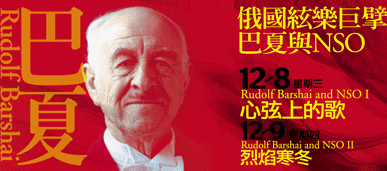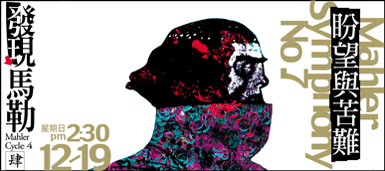|
《第七號交響曲》,又稱為《夜之曲》,是馬勒第二創作期的最後作品。這首交響曲為馬勒一九○四年夏天在麥格尼爾避暑時所作,龐大的器樂編制,展現創作當時的強烈企圖。
第一樂章,莊重的序奏,逐漸發展的高潮,氣勢強大而華麗。第二樂章,進行曲性格的夜曲,時而愉悅,時而平靜。第三樂章詼諧曲,時而明朗,時而詭異,難以捉摸的迷離。第四樂章的夜曲,深情款款,溫暖而朦朧。第五樂章,曲式雄壯威武,節奏明朗快樂,以輝煌的結束表現大開大闔的氣魄。全曲明快且戲劇化的表現方式,仍符合馬勒的創作性格。
根據指揮家Willem Mengelberg的紀錄,馬勒曾以「希望」及「人類的苦難」解釋這首樂曲,足見全曲仍呈現馬勒一貫「樂觀中看見絕望,悲劇中預見勝利」的矛盾本質。透過馬勒犀利的雙眼,我們似乎也能凝視時間中流轉的希望與苦難。
來自日本的井上道義,在詮釋馬勒的作品上,有其獨到手法。本次來台,井上為你獻上這場台灣樂壇難得一見的馬勒作品,撥開《夜之曲》的朦朧面紗,看見馬勒的創作面貌。
Mahler The Symphony No.7, also called "night
music," was the last symphonic writing in his second
composing period. At that time, Mahler was spending his summer
in Maiernigg in 1904. A magnificent instrumental setting demonstrated
the composer’s powerful attempt at the time.
In the first movement, Langsam-Allegro risoluto,
ma non troppo, the structure is gradually expanded into the
apex with the strong and grand manner. In the second movement,
Nachtmusik: Allegro moderato, the delightful and peaceful
character appears occasionally. In the third movement, Scherzo
Schattenhaft, the dazzling and stealthy character reveals
somewhat untenable quality. In the fourth movement, Nachtmusik:
Andante amoroso, the deep feeling produces a warm and hazy
atmosphere. In the fifth movement, Rondo-Finale, the majestic
form combines the vigorous rhythm throughout the entire music,
then joins with the brilliant ending. With such a dramatic
creation, it matches the composer’s distinct characteristic.
According to the conductor, Willem Mengelberg,
Mahler attempted to interpret the work by using the contents
of the hopefulness and the suffering of human beings. This
is consistent with the composer’s contradictory nature, that
is via to picture despair via optimism and to predict victory
in tragedy. Throughout Mahler’s sharp eyes, we seem to visualize
hope and suffering in the flow of times.
The Japanese conductor, Michiyoshi Inoue,
has his distinct thoughts to interpret of Mahler’s work. In
this concert, he will bring this rare performed symphony to
the stage of Taiwan. To unmask the cover of this "night
music," you’d discover Mahler’s creative composition.
日 期
|
2004年12月19日 星期日 14:30 |
| 地 點 |
國家音樂廳 National Concert
Hall |
演出者
|
指揮:井上道義
Michiyoshi Inoue, conductor |
曲 目
|
馬勒:第七號交響曲
G. MAHLER: Symphony No. 7 |
|





